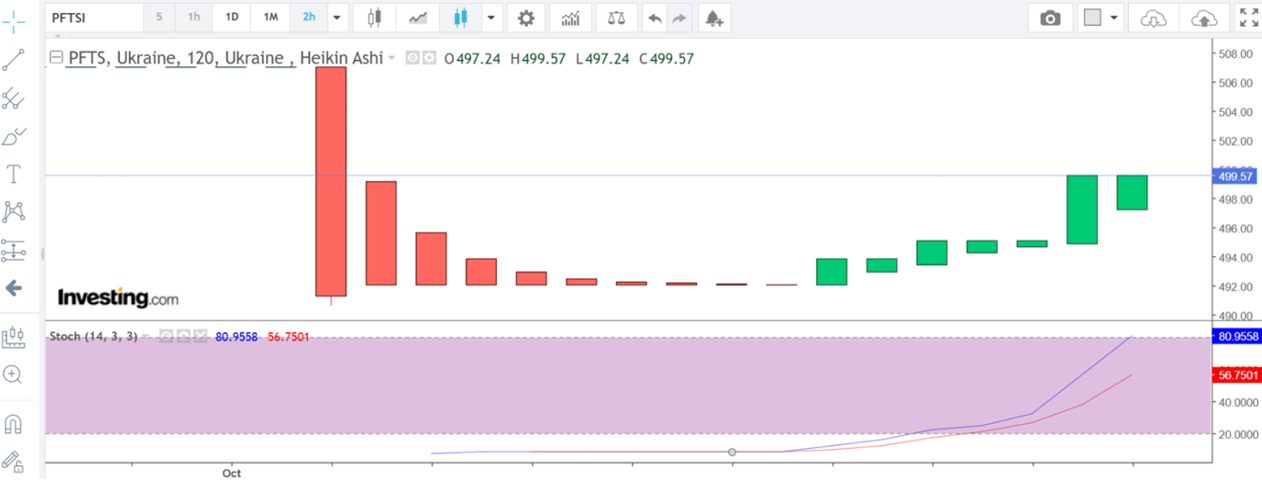CFD Trading In Ukraine



Interested in placing short-term trades on a wide range of instruments, from Ukrainian stocks like Metinvest to currency pairs like USD/UAH, alongside the opportunity to profit from both rising and falling markets?
Enter contracts for difference, or CFDs, which let you speculate on price changes in various markets without actually owning the assets. This flexibility has made it increasingly popular, but there are unique aspects to consider when CFD trading in Ukraine.
This beginner’s guide breaks down the essentials, from navigating Ukraine’s regulatory landscape and tax considerations to an illustrative trade on Ukraine’s chief stock market index.
Quick Introduction
- CFDs give you access to a vast range of markets – from US stocks and European indices to commodities and currencies. This reach means you can diversify your portfolio and respond to international economic trends without opening accounts in foreign markets.
- CFDs are often traded with leverage, allowing you to control large positions with a smaller investment. With 1:20 leverage, you could manage a Ukrainian hryvnia (UAH) 100,000 position with only 5,000. Leverage amplifies gains, though it also increases losses, so risk management is key.
- CFD trading’s ability to go long or short in a market with economic uncertainties or currency fluctuations can be an advantage. For example, if the Ukrainian hryvnia experiences fluctuations against the dollar, you can speculate on the USD/UAH in both directions.
- Since CFDs are derivatives, you don’t own the underlying asset, meaning you can avoid costs like stamp duty, transfer fees, or asset transfer charges. This is especially beneficial for day traders focusing on short-term positions, as it keeps trading costs low.
Best CFD Brokers In Ukraine
Through our hands-on assessments, we’ve determined that these 4 CFD trading platforms are the best for traders in Ukraine:
How Does CFD Trading Work?
CFDs offer access to global financial markets without the extra expense and administration needed to purchase the actual assets. With CFDs, you trade on margin and can use the available leverage offered by CFD brokers to predict whether the price of an asset will go up or down.
Used well, leverage is a powerful tool and an attractive element of CFD trading. You can open and control more significant positions but only need to commit a small portion of the total value (or margin) required to buy an equivalent number of shares listed on a stock market.
To unpack this, we’ll look at a Ukrainian stock market index to illustrate a potential CFD trading opportunity. The Ukraine PFTS Index is a benchmark stock market index that tracks the performance of major companies listed on the Ukrainian PFTS Stock Exchange.
Let’s say you believe the PFTS will rise; in that case, you might want to buy a long CFD position in the index. If each contract is valued at UAH 500, and your brokerage requires a 5% margin, then to take a position on 1000 contracts, you’d need a margin of UAH 25,000 (500 per contract x 100 contracts x 5%).
If the PFTS Index rises to 600, the price increase will yield UAH 100 per contract. By closing your position, you could get a total profit of UAH 100,000 (1000 contracts x UAH 100), excluding charges from your brokerage. But, if the index falls to 400, you would lose UAH 100,000.
This example illustrates the risk of CFD trading; you get to control significant size with leverage, but both the gains and losses can increase.
Understanding how the phenomena of margin and leverage work is critical to your trading success.If you are new to CFD trading, consider a demo trading account. It’s a terrific introduction to CFD trading; you can practice strategies and build confidence before risking your real funds in the markets.
What Can I Trade?
CFD trading in Ukraine delivers many trading opportunities in many financial markets, both globally and in Ukraine.
- Stock CFDs – You can trade individual Ukrainian stocks listed on the PFTS Stock Exchange or equities from European, US, UK, and other global markets. Individual stocks can experience large price swings suitable for day trading.
- Index CFDs – The PFTS Index can be traded as a CFD in Ukraine. It is a benchmark capitalization-weighted stock market index tracking the performance of major companies listed on the Ukrainian PFTS Stock Exchange. Many CFD traders prefer indices to capitalize on a stock exchange’s overall performance rather than invest in individual shares. You could also consider trading global index CFDs like the Dow Jones or NASDAQ. Liquidity is always high in these popular indices. As a consequence of the liquidity, the trading costs are generally competitive.
- Forex CFDs – The UAH is traded in the foreign exchange market. Popular Ukrainian currency pairs include UAH/USD and UAH/EUR, alongside majors like EUR/USD and USD/JPY. These currency pairs are liquidity-rich and can provide opportunities for short-term currency traders.
- Commodity CFDs – Vital commodities like gold, silver, crude oil and wheat (Ukraine is one of the world’s largest exporters) can be easily traded as CFDs. You can speculate on their price movements, which are often linked to macroeconomic events.
- Crypto CFDs – The excitement and curiosity over trading digital assets has reached Ukraine. Residents can trade cryptocurrency CFDs like Bitcoin and Ethereum for exciting but very high-risk trading opportunities.
Is CFD Trading Legal In Ukraine?
CFD trading is legal in Ukraine but not regulated with the same level of scrutiny as in some other countries.
The National Securities and Stock Market Commission (NSSMC) oversees financial markets and securities, and while it provides general oversight, there are no specific, detailed regulations focused exclusively on CFDs.
Ukrainian traders often rely on international CFD brokers based in regions with stricter rules, such as the European Union (regulated by ESMA), the United Kingdom (FCA), or Australia (ASIC).
These providers must comply with rigorous standards. For instance, EU-based brokers follow the European Securities and Markets Authority (ESMA) guidelines, which include leverage limits and mandatory client protections like negative balance protection.
Without strict local regulations, there may be fewer protections against broker malpractices. For instance, choosing a firm with negative balance protection (standard in some international markets but not locally enforced) is vital to ensure you can’t lose more than your initial investment.
Additionally, Ukrainians should be cautious of unlicensed brokers, as the lack of local regulation can attract unreliable providers.
As Ukraine’s regulatory environment evolves, traders should remain informed and prioritize safety by choosing reputable, regulated CFD trading platforms that offer added protections without robust local oversight.
Is CFD Trading Taxed In Ukraine?
Yes, CFD trading is taxed in Ukraine.
Profits from CFD trading are part of an individual’s taxable income and are subject to Ukraine’s standard personal income tax rate of 18%. This applies to net gains from trading, meaning you would pay tax on your profits after subtracting any losses incurred within the same tax period.
Ukraine imposes a 1.5% military levy on income, including gains from CFD trading. This levy was introduced to support national defence and applies to all forms of income, bringing the total tax on CFD trading profits to 19.5%.
It’s essential to keep detailed records of your trades, as the tax authorities may request documentation to support your reported income.
Losses from CFD trading can typically offset gains within the same tax year. However, it’s always a good idea to consult a tax advisor for guidance on claiming any deductions or offsetting losses properly to ensure compliance with Ukrainian tax laws.
An Example Trade
Let’s walk through a detailed CFD trade from start to finish.
I’ve decided to trade the main Ukrainian stock market index, the PFTS Index. When searching for examples of trades in unfamiliar, overseas markets that might be compromised or thin on liquidity, I’ll often defer to an index rather than trade an individual stock.
Why? Indices typically have deep liquidity and trading volume; therefore, my broker’s fills, spreads, commissions, and the stable trading conditions on an index can be conducive to good trading experiences.
Technical Analysis
I keep my charts uncluttered and my technical analysis simple, as overanalyzing can lead to trade paralysis. Conflicting data feedback can cause you to become so confused that your decision-making freezes.
You only need at most one indicator from the groups commonly referred to in technical analysis. Those groups are: momentum, trend, volume and volatility. You could also add overbought/oversold to that grouping list.
However, you must remember that specific indicators like the MACD can illustrate both trends and momentum. The RSI will help you pinpoint both volume/volatility and oversold/overbought conditions. So, with careful selection, you can limit the indicator choices on your chart to prevent confusion.
In this instance, I’ll be using a mostly naked chart with the addition of only one technical indicator. The stochastic oscillator operates on the principle that prices tend to close near the high end of the trading range in an uptrend and near the low end in a downtrend.
As an oscillator, it gives insights into the momentum behind price movements and helps identify possible turning points in the market.
I use the stochastic oscillator to identify momentum shifts and potential reversal points, so it does the job of several indicators in some ways; you can see a trend developing, momentum building and oversold/overbought conditions.
2HR Timeframe
The below chart clearly shows three periods: bearish, ranging, and bullish. The ranging period, when price failed to make new highs or lows, provided the ideal opportunity to assess market conditions and await a signal to go long.
The Heikin Ashi candlestick formation displays a textbook-ranging pattern over a full day’s trading, indicating indecision and a balance between buyers and sellers.

My entry signal arrived when the stochastic lines crossed on a setting of 14,3,3 after being locked in the oversold area for the previous trading sessions. This 14,3,3 setting is popular among swing traders, especially if plotted on lower time frames such as the 2HR and 4HR.
Before entering, I waited for confirmation through bullish Heikin Ashi candlesticks and the stochastic lines near the 50 level.
My entry order using a CFD was filled at 494. The 20% margin on the equivalent of 100 contracts was 9,880 (494 X 100 X 20%), about €225.
My original stop loss order was 490, and my take profit limit order was set at 500. As the trade moved into profit, I adjusted my stop to the more recent low and entry point 494.My risk and cost on this trade are now minimal, amounting to fees and commissions. If the limit order doesn’t trigger in the next day’s session, I may close the trade, hopefully in profit.
Bottom Line
CFDs are a versatile and accessible option for traders in Ukraine who want to explore global markets, leverage their positions, and take advantage of diverse trading conditions, all while keeping trading costs down.
However, it comes with important considerations: taxes on profits, which include a combined 19.5% rate for income tax and military levy, and the evolving regulatory environment, which may impact trading conditions.
By staying informed on tax obligations and potential regulatory updates, Ukrainian traders can navigate the market confidently and make the most of their trading experience. Still, never risk more than you can afford to lose.
To kickstart your journey, see DayTrading.com’s selection of the best CFD day trading platforms.
Recommended Reading
Article Sources
- PFTS Index - Trading Economics
- PFTS Stock Exchange
- National Securities and Stock Market Commission (NSSMC)
- European Securities Markets Authority (ESMA)
The writing and editorial team at DayTrading.com use credible sources to support their work. These include government agencies, white papers, research institutes, and engagement with industry professionals. Content is written free from bias and is fact-checked where appropriate. Learn more about why you can trust DayTrading.com



